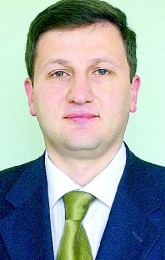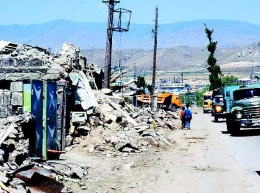Armenia’s Ambassador to Ireland, Dr Vahe Gabrielyan, speaks to Metro Éireann about his country’s links with Ireland, conflict in the Nagorno-Karabakh region, and reconciling Armenia’s close Russian ties with its European aspirations
Dr Vahe Gabrielyan was appointed Ar-menia’s Ambassador to the United Kingdom in March 2003 and to Ireland in December 2005, becoming the first ever Ambassador of the Republic of Armenia to this country.
Before his ambassadorial tenure he was press secretary for the President of Armenia from 1998 to 2003. At the same time he served as the president’s interpreter, and previously worked at the Ministry of Foreign Affairs of Armenia in various capacities from 1994 to 1998. He has held positions at the UN, OSCE and later Unesco desks of the Depar-tment of International Organ-isations of the Ministry, and he has also worked at the Consti-tutional Court of Armenia.
Dr Gabrielyan took the time to answer our questions on various topics, from the links between Ireland and Armenia to the conflict in Nagorno-Karabakh, and his country’s future in Europe.
Metro Éireann: You are the first ever Ambassador of Armenia to the UK with an added brief in Ireland. Can you give your impression of Ireland during your visits?
Dr Vahe Gabrielyan: I had special feelings for Ireland, the Irish people and their history even before I was considered for the job and felt really privileged and proud to be appointed Armenia’s Ambassador to Ireland, moreover the first ever one.
All my visits to Dublin have been enjoyable, whether on my own or accompanied with my family. Of course, the most memorable day was the one when I presented my credentials. All the officials from the Foreign Ministry and the President’s office were very welcoming and helpful but I was most impressed when I met President Mary McAleese.
The ceremony was very solemn and inspiring and the inspecting of the guard was an obliging experience, however I was touched by the President’s warm welcome to myself and my family and her knowledge of Armenia and our history. I was very pleased for her assessment of the resemblance between our two nations’ histories, fate and character and her offer of assistance in my mission was indeed encouraging.
These were words every diplomat wants to hear. I just hope we will see her visit Armenia before long and share this mood with the Armenian people.
ME: What is the exact nature of Armenian-Irish relations? On what cultural, political and trade matters do we co-operate?
VG: We should realise that Armenian-Irish relations on a government-to-government level are in their very young days. We have had contacts earlier, of course, but on an official level we are in the initial stages, although I must mention with satisfaction that we have already had high-level contact.
Not long after my appointment, the then Foreign Minister Mr Dermot Ahern TD invited our Foreign Minister of that time, Mr Vartan Oskanian, to visit Dublin in the beginning of 2007. This was the first ever visit of an Armenian Foreign Minister and we covered a lot of ground, [including] ways of developing co-operation bet-ween the two nations.
There are indeed many areas where we can closely co-operate. We are interested in Ireland’s experience of European integration, economic achievement and conflict resolution, in regulating relations with a large diaspora, etc.
Apart from the political dimension, which we intend to expand on, we are very keen on developing comprehensive economic co-operation. From my very first visits I had meetings at the Chambers of Commerce of Ireland and we started a process of establishing co-operation between them and the chamber of commerce in Armenia. The process has stalled for a while but we plan to rejuvenate it.
Being small countries quite far apart geographically obviously causes some difficulties, and having no embassies in each other’s capital cities does not help either, therefore we have nominated one of our compatriots, a successful Armenian-Irish businessman, to be our honorary consul who, being a Dubliner for decades, can pursue trade issues on a much more regular basis. We have received the consent of the Irish authorities and hopefully, pending some legislative amendments to our respective procedures in Armenia, will appoint him before long.
We are also in the process of finalising an agreement on avoiding double taxation which will be a good start, encouraging the business communities on both sides to more seriously look into doing business with each other.
ME: In what areas do you see prospects for economic relations between our two countries?
VG: Apart from the traditional branches of economy such as mining, heavy industry, chemical industry, textiles and agriculture, Armenians have always been good, like the Irish, in spheres of economy requiring high-standard education, advanced skills and brainpower, spheres such as information technologies, hi-tech software development, re-search, banking as well as industries for which geographical barriers and transportation costs are not important – diamond cutting and refining, jewellery making, etc. Tourism is one of those with the highest potential, as are organic food production, food processing and intellectual services.
I would like to go back to the previous question for a moment and add that cultural relations of course are not at the bottom of our list. It is not by chance that the first thing we did in Ireland was organise an exhibition of photographs in the Central Library in Dublin, depicting the beautiful scenery, history, architectural and cultural monuments and everyday life of Armenia as seen by 15 professional photographers.
And while we are on the subject of culture, I would like to mention with pride the Armenian collection at the Chester Beatty Library in Dublin. This is said to be the largest collection of medieval illustrated Armenian manuscripts not in Armenian hands. We Armenians – who invented our alphabet in 406 and put it into uninterrupted use since – have a special reverence for the written word, the books and the spiritual in general and boast a unique collection of over 17,000 medieval manuscripts in the Matenadaran, the depositary of ancient manuscripts in Yerevan. The second, hugely important collection is maintained and researched at the Mekhitarist Abbey in Venice, while another unique collection is kept in the Armenian Quarter in Jerusalem.
The one in the Chester Beatty is unique in being not in Armenian hands. I would like to take this opportunity to sincerely thank the director of the library, the curator of the exhibition and all Chester Beatty staff for the wonderful work they are doing by preserving this important cultural heritage.
ME: How many Armenians are in Ireland, and in general, what types of experiences – good and bad – do they report to the embassy as regards life here?
VG: As for probably any community, speaking of precise numbers is not realistic; exact statistics simply do not exist. However, we know that there are not many Armenians in Ireland by any count, and those who are known do not live concentrated in one place.
The Armenian community in Ireland has not been, until very recently, formally organised around any structures. They have recently started talking about establishing some sort of a community centre, possibly also a Sunday school and having organised Sunday Mass. The embassy undoubtedly encourages such activity and we hope to see a coherent community that can contribute to Armenian-Irish bilateral relations.
From whatever contacts we have had, we have no reports of any bad experience. On the contrary – and I want to specially mention this – in 1988, in the aftermath of the devastating earthquake in Armenia, the Irish people showed their warmth and generosity and were of great assistance both morally and materially. That attitude means a lot to us and will not be forgotten.
ME: Can you explain the current status of the Nagorno-Karabakh conflict, and whether those involved in the Northern Ireland peace process have offered any advice to the government of Armenia in solving this?
VG: The Nagorno-Karabakh conflict is one of the most intricate conflicts of our time because of several factors: it has a long history; has claimed a terrible number of lives; and is in a very complex region where many powers have interests.
Let me explain its roots as briefly as possible. After the Bolshevik revolution in Russia, countries of the south Caucasus, Armenia and Georgia – formerly part of the Russian Empire – became independent in 1918 and a new country, Azerbaijan, was also formed. The latter had claims for Karabakh, part of the ancient Armenian province of Artsakh, but these claims were considered so unfounded by the League of Nations that it did not grant Azerbaijan membership.
When the three countries where sovietised by the Red Army in 1920, the authorities of Soviet Azerbaijan formally acknowledged that Karabakh was part of Armenia. However, a year later the Communist authorities in Moscow decided to re-draw the borders in the Caucasus at their own whim and thus cut two big chunks of indigenous Armenian lands, Nakhichevan and Karabakh, and ‘presented’ them to Azerbaijan, albeit with some degree of formal autonomy.
Armenians never reconciled with this fact and kept protesting, but not much was possible under either the Leninist ‘internationalist’ dogma or Stalinist repression. Consequently, under continuing oppression from Azeri authorities, all the Armenian population of Nakhichevan were ousted, and some demographic change was forced in Nagorno-Karabakh through various means of discrimination and violation of human rights.
When Gorbachev’s ‘perestroika’ offered hopes for democracy and justice, Armenians in Karabakh raised their voice through legislative procedures and demanded a restoration of justice. Repressions and organised pogroms of Armenians followed, and when the Soviet Union collapsed, these attacks grew into full-scale outright military aggression against the civilian population.
A bigger part of Karabakh came under Azeri occupation, the population was killed or fled, towns and villages were destroyed, while the rest – the still unoccupied parts – were bombed and shelled around the clock. Karabakh was able to organise self-defence and ultimately beat the Azeris against the odds, liberating most of the territory and establishing control over some adjacent lands. Almost all Karabakhi men went to fight to protect their families and homes.
A formal ceasefire was established in 1994 and still holds, although shootings are still frequent. A negotiating format, co-chaired by the US, Russia and France and including about another 10 countries was put together by the OSCE in the early 1990s and has since been working on finding a resolution acceptable to all parties. Several proposals have been put on the table since then and rejected by one or more of the three parties (Azerbaijan, Nagorno Karabakh and Armenia), the last three of them by Azerbaijan.
Meanwhile, Karabakh has managed to hold a referendum, declare independence, conduct three presidential, parliamentary and local elections, and is successfully building a democratic independent state, working hard to improve the welfare of its people and eliminate the consequences of the war imposed on them.
One major impediment to the peace process is that Azerbaijan refuses to directly talk to the Nagorno-Karabakh authorities, which is counter to logic, because the conflict is in the first place between Azerbaijan and Karabakh.
Most recently, on 2 November 2008, a declaration on the prospects of a political settlement for the Nagorno-Karabakh conflict was signed by the presidents of Armenia, Azerbaijan and the Russian Federation, committing the parties to the non-use of force and resolution of the conflict by peaceful means only. We think that the signing of such a declaration is quite an important development.
Being involved in such an intricate conflict and lengthy negotiations, we are of course interested in other nations’ experience in conflict resolution and carefully study all available sources. We are impressed with the progress in the Northern Ireland talks and genuinely happy that this long-standing conflict is finally coming to an end.
ME: Like Ireland, Armenia has a massive diaspora. What does the government of Armenia do, through its embassies, to ensure that the culture and traditions of Armenians are maintained when abroad?
VG: At least two-thirds of Armenians live outside Armenia – or the Republic of Armenia, for the bigger part of Armenia, or western Armenia, is now part of Turkey. The reason for the existence of such a massive diaspora is not the free choice to live where one wishes.
There has certainly been economic emigration since independence was restored in 1991. With the demise of the Soviet Union, the economy – already under big strain because of the 1988 earthquake that destroyed a third of the country, and because of the hundreds of thousands of Armenian refugees fleeing pogroms in Azerbaijan – deteriorated to an unprecedented low. The blockades imposed by Azerbaijan and Turkey further aggravated the situation and a considerable number of people left Armenia to find jobs and security.
The diaspora, however, was not formed by these people. It came into existence when hundreds of thousands were deported from their homes in western Armenia, then part of the Ottoman Empire (now Turkey) at the beginning of the 20th century. In a centrally planned, government-executed annihilation campaign of Armenians that started under Sultan Hamid at the end of the 19th century and culminated, under the Young Turks, in 1915 in the first genocide of the 20th century, all the population of western Armenia was exterminated. At least 1.5 million perished in the slaughter or died of hunger and exhaustion in the deportation through the deserts, while the rest fled for other countries.
When one speaks of the Armenian diaspora – a generic name for the now confident, prospering, respected, and increasingly influential communities all over the globe – the history of how it came about should always be borne in mind because this historic memory is a defining feature of their psychology and activities.
Today, apart from maintaining their identity and their well-being, the Armenian diaspora pursues two major issues: the international recognition and condemnation of the 1915 genocide of Armenians – which Turkey still refuses – and the strengthening of the Republic of Armenia.
We co-operate with the diaspora in all possible directions, including the strengthening and deepening of our bilateral relations with the countries where we have communities. Armenians are always loyal, law-abiding and hard-working citizens of the countries where they reside and act as a useful bridge for furthering bilateral relations. The Armenian diaspora is an important part of the nation and a valuable asset, and we do our best to help the people and enhance their ties with their homeland. In this light, we are very keen to learn from the Irish experience of developing the relations between the homeland and the diaspora.
As for embassies, working with the communities is an important part of our job. We work very closely with both structures and individuals of respective communities on a multitude of issues – political, trade, cultural, educational, tourism, investments, etc. We have already achieved a lot and intend to constantly build on that.
ME: There is confusion among onlookers as to whether Armenia wishes to eventually join the EU. Some say that popular opinion backs such a move, but that the government’s foreign policy favours the continuation of close ties with Russia and the Commonwealth of Independent States (CIS). What is the reality of the situation from your perspective?
VG: Let me start with the CIS and Russia. As one would appreciate, Armenia – at least eastern Armenia – was for a long time part of the Russian Empire and, for over 70 years, of the Soviet Union. Throughout these years, we have built not only deep economic ties but also cultural, educational, historic people-to-people relations with others with whom we were part of the same country. We should maintain these ties of friendship and co-operation and build on them for our own benefit.
A lot of Armenians live in the CIS countries and our community in Russia is the largest among all our communities in the diaspora. In addition, many families in Armenia have someone working in these countries on a seasonal basis as well.
Russia is also a strategic partner and a very significant economic partner and investor in our economy. All these ties are in our own interest.
Having said this, I must make it clear that integration into the European community, structures and economy is a government priority policy that we have announced since the early years of independence, as well an express wish of the public.
As the first country in the world to adopt Christianity as a state religion in 301, we believe that we are bearers of European values and Europe is where we belong.
The policies of European integration that we have pursued consistently are by no means contradictory to our maintaining of good relations with Russia or the CIS countries. The two can successfully complement each other and there is no disagreement – well at least on this issue – between public opinion and the Government’s foreign policy.
We do see ourselves in Europe but understand well that we still have much work to do to achieve the way of life that we aspire.
We also believe that once our aims and declared direction of development are clear, they will be reached not by making loud statements and claims, but through consistency of action, hard work and determination.
We hope that Ireland will stand by a friendly nation once or when the need to assist on this road arises.
Agallamh le hAmbasadóir na hAirméine chun na hÉireann
Ceapadh Vahe Gabri-elyan mar Ambasadóir na hAirméine chun na Ríochta Aontaithe i mí an Mhárta 2003 agus mar Ambasadóir na hAirméine chun na hÉireann i mí na Nollag 2005, agus é ina chéad Ambasadóir riamh de Poblacht na hAirméine in Éirinn. Sula raibh sé ina Ambasadóir bhí sé ina Phreasrúnaí d’Uachtarán na hAirméine don tréimhse idir 1998 agus 2003. Ag an am céanna, d’oibrigh sé mar ateangaire don Uachtarán agus d’oibrigh sé i Roinn Gnóthaí Eachtracha na hAirméine i róil éagsúla ón mbliain 1994 go dtí 1998. Bhí post aige sna Náisiúin Aontaithe (UN), in Eagraíocht na Náisiún Aontaithe um Shlándáil agus Chomhoibriú san Eoraip (OSCE) agus, ina dhiaidh sin san Eagraíocht Oideachais, Eolaíochta agus Chultúir na Náisiún Aontaithe (UNESCO) i Rannóg na nEagraíochtaí Idirnáisiúnta sa Roinn sin. D’oibrigh sé chomh maith i gCúirt Bhunreacht na hAirméine.
Is tusa céad Ambasadóir na hAirméine riamh chun na Ríochta Aontaithe agus chun na hÉireann. Conas a chuaigh Éire i bhfeidhm ort le linn do chuairte?
Bhí mothúcháin speisialta agam d’Éirinn, do mhuintir na hÉireann agus do stair an tíre fiú sula a smaoiníodh orm don phost agus bhí sé de phribhléid agam, agus bhí mé thar a bheith bródúil, nuair a ceapadh mé mar Ambasadóir na hAirméine chun na hÉireann, an chéad Ambasadóir riamh chun na tíre seo.
Bhain mé taitneamh as gach cuairt a thug mé ar Bhaile Átha Cliath, na cinn nuair a bhí mé i m’aonar agus na cinn nuair a bhí mo chlann liom. Is cinnte, áfach, gurb í an chuimhne is buaine atá agam ná an lá a bhain mé na dintiúir amach. Chuir feidhmeannaigh ón Roinn Gnóthaí Eachtracha agus ó oifig an Uachtaráin fearadh na fáilte romham agus bhí siad an-chabhrach go deo liom, ach an rud is mó a chuaigh i bhfeidhm orm ar an lá ná nuair a bhuail mé leis an Uachtarán Mary McAleese. Searmanas an-sollúnta agus inspioráideach a bhí ann agus ba thaithí ar leith a bhí i gcigireacht na ngardaí. Chuaigh an fháilte ó chroí a chuir an tUachtarán romhainn, mé féin agus mo chlann, i bhfeidhm go mór orainn go léir mar aon leis an méid a bhí ar eolas aici faoin Airméin agus faoi stair na tíre. Bhí mé an-sásta leis na cosúlachtaí ar labhair sí fúthu idir stair, cinniúint agus carachtar an dá thír agus thairg sí tacaíocht dom le linn mo mhisean a chomhlíonadh, rud a chuir ardú meanman ionam. Teastaíonn ó chuile thaidhleoir beo na focail sin a chloisteáil. Tá súil agam go dtabharfaidh sí cuairt ar an Airméin sula i bhfad agus go scaipfidh sí an dea-spin seo ar mhuintir na hAirméine.
Cén caidreamh go díreach atá idir an Airméin agus Éire maidir le cúrsaí cultúir, polaitíochta agus trádála?
Ba chóir dúinn tabhairt faoi deara nach bhfuil ach tús curtha leis an gcaidreamh idir an Airméin agus Éire ar leibhéal na rialtas. Bhí teagmháil idir an dá thír roimhe seo cinnte ach ar leibhéal oifigiúil, táimid sa chead chéim den phróiseas, ach cuireann sé áthas orm mé a lua go raibh teagmháil ardleibhéal ar siúl eadrainn go dtí seo. Seal beag i ndiaidh dom a bheith ceaptha, thug Aire Gnóthaí Eachtracha na hÉireann, an tUasal Dermot Ahern TD, cuireadh dár nAire Gnóthaí Eachtracha, an tUasal Vartan Oskanian, teacht go hÉirinn ag tús 2007. Ba í seo an chéad uair a thug Aire Gnóthaí Eachtracha na hAirméine cuairt ar Éirinn agus pléadh an-chuid rudaí… ina measc, slite le comhoibriú a fhorbairt idir an dá thír. Is fíor a rá go bhfuil go leor réimsí inar féidir linn comhoibriú go dlúth: tá suim againn sa taithí atá ag Éirinn maidir le comhtháthú san Eoraip, maidir le héachtaí eacnamaíochta agus le réiteach coimhlinte, agus maidir le caidreamh a rialú le Diaspóra mór srl.
Taobh amuigh den réimse polaitíochta, réimse ina bhfuiltear ag súil le fás agus forbairt, tá an-spéis againn i gcomhoibriú eacnamaíochta cuimsitheach a fhorbairt. Ó na chéad chuairteanna a thug mise ar Éirinn, bhí cruinnithe agam ag Cumann Lucht Tráchtála na hÉireann agus chuireamar tús le próiseas chun comhoibriú a bhunú idir Cumann Lucht Tráchtála na hÉireann agus Cumann Lucht Tráchtála na hAirméine. Cuireadh moill ar an bpróiseas ar feadh tamaill ach tá sé ar intinn againn é a chur faoi lánseol arís.
Tá deacrachtaí ag baint le bheith i do thír bheag agus a bheith suite i bhfad óna chéile, agus is dúshlán eile é nach bhfuil ambasáid againn i bpríomhchathracha a chéile. Ainmníodh, mar sin, duine dár muintir féin, fear gnó idir an Airméin agus Éire mar Chonsal Oinigh. Is Baile Átha Cliathach é le blianta anuas agus is féidir leis a choinneáil leis an gcúram maidir le cúrsaí trádála ar bhonn níos rialta.
Tá cead faighte againn ó údaráis na hÉireann agus le cúnamh Dé, ceapfar é sula i bhfad nuair a chuirfear roinnt leasuithe reachtaíochta i bhfeidhm, leasuithe a bhaineann leis na nósanna imeachta san Airméin.
Faoi láthair, táimid ag cur críche le comhaontú maidir le cáin dhúbailte a sheachaint agus is tús maith é sin mar spreagfaidh sé na pobail ghnó sa dá thír aghaidh a thabhairt ar ghnó a dhéanamh lena chéile.













